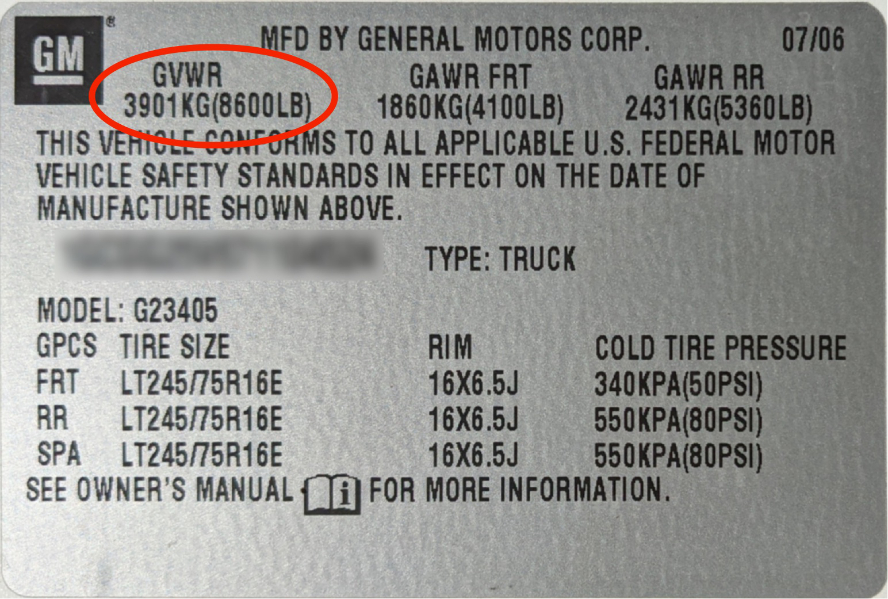
We might not be able to take it all with us when we die, but some of us nomads try to take as much as we can while we still roll on the earth. Whatever your mobile abode might be, from a compact car to a travel trailer or Class A motorhome, there’s a limit to how much you can take. It’s not simply a matter of space. It’s also about weight.
Does the rear of your rig sag? Do your springs bottom out over mild bumps? Is the handling squirrely? Do you need to really mash the brakes to stop? You might be overloaded.
MEASURING VEHICLE WEIGHT
All vehicles and trailers are rated for maximum weight. The numbers are on a sticker in the frame of the driver’s door or in a prominent place on a trailer. They are also in owner’s manuals and online.
Gross Vehicle Weight (GVW): Sometimes called dry weight or curb weight. This is the weight of a vehicle as it rolls off the assembly line. This can vary between different vehicles of the same brand and model, depending upon the factory installed options.
Gross Vehicle Weight Rating (GVWR): This is the maximum total weight of the vehicle, fuel, passengers, owner-added parts, and cargo. This is your weight rolling down the road. The whole enchilada.

Maximum Load Capacity: This is how much weight your vehicle can safely carry. This is the GVWR minus the GVW. In addition to whatever you might load into or onto the vehicle, it also includes the tongue weight of whatever you’re towing.
Gross Axle Weight Rating (front and rear): These numbers give you a rough idea of how to—or not to—distribute the load in your vehicle. In the case of trailers (single or multiple axles) it serves much the same purpose as GVWR.
Tire Load Rating: This is the maximum weight each tire can safely carry when properly inflated. The rating is on the tire. The inflation numbers are also on a door frame sticker. Front and rear tire pressures may vary since front and rear axle weights also vary. The tire load rating, times the number of tires, should be greater than the GVWR.
Trailer Tongue Weight: This is the amount of downforce a trailer places on the hitch. It will vary depending on how heavily you load the trailer and where you distribute the weight. Think of a teeter-totter.
WHY DOES THIS MATTER?
This isn’t the preaching of radical minimalists condemning the amount of soul corrupting stuff you lug around. Exceeding weight ratings invites trouble.
-
- Bad or even out of control handling
- Bad braking
- Lower fuel mileage
- Faster tire wear
- Loss of suspension travel
- Worn or broken suspension parts
- Shorter engine and transmission life
- Tickets
- Criminal liability in the event of an accident (See out of control handling and bad braking above.)
No, we don’t want any of that.
Just because you are currently able to drive without incident, it doesn’t mean you are safe or that your rig is happy.
WHAT TO DO
To make sure you’re not overloaded, or to learn you can carry more after all, weigh your rig at a public scale. Compare that number to your GVWR. Adjust accordingly and have one less thing to worry about.
Since I try to practice what I preach, I weighed my 2007 Chevrolet Express 2500. The sticker on my door lists the Gross Vehicle Weight Rating as 8,600 pounds. The Gross Vehicle Weight is 5,195 pounds. The Maximum Load Capacity is 3,405 pounds. The public scale in Blythe, California registered 6,914 pounds. That means I’m carrying 1,719 pounds of stuff (measured weight minus GVW)—a little over half of what I could. Looks like I’m good to go. What about you?

I considered all this having driven my parents way overloaded 35ft Holiday Rambler Aluma-lite trailer all over the western United States for two years. I’m completing my van build this summer. I took out 300lbs of seating, steal connectors, decorative interior, and back section heat & air. The van was designed to carry 12 passengers. It’s a ford e-350 super duty xl. It’s got 3/4 ton wheels. I decided that 5/8 inch CDX plywood would make bridging over the variations in wall depth easier to insulate and build from. That weighed in at 500lbs. So I have an aggregate increase in weight of 200lbs in an otherwise empty van. I already know that you don’t need 2,000lbs extra junk to be happy. It’s nice to have a barbecue for outdoor cooking. The only big ticket items in weight are the batteries for solar, the fresh water tank at 30 gallons, and the black water tank at 31 gallons. All you need to survive is food, clothing, and a place to sleep. All you need to not go crazy is all the junk. You need an outdoor folding chair to be sociable. You need a way to cook and store perishable food. I learned just how little I actually need growing up as a mountaineer. All you have is what you can carry on your back.
“Too much stuff” has been my major problem. It’s not as crazy as the picture but carrying something in limited space that has not been used in a year is nuts… Or so I told myself every time I moved moved it…
It’s good to see the blog back in use!
Thak you for this easily understood information. I wondered how I could figure weights out.
I know I’m caring too much weight because I have two hammers and a horseshoe that I don’t hardly use. There are other things in my van that I’m stuffed with too many clothes and maybe too many books. Thanks for the information I will be making my adjustments soon
Thank you for this useful information- I’ve wondered how I would calculate the weight I’m carrying-
I know we are overweight! I carry a LOT of fabric for quilting, two sewing machines, and a tool box of sewing notions! We bought larger tires, and have replaced our axle!
Thank you for the info.
I got rid of close to 1000 lbs of books when I transitioned into my ambulance and it was the hardest thing to do! Also gone is my collection of vintage Pyrex and my stereo equipment plus my beloved albums…..It’s amazing how much “stuff” we collect, and even more amazing is how much precious money is essentially wasted on said items! I pared down my books to my absolute favourites that fit into one cabinet. I now frequent the roadside lenders library boxes all over town ( I’m in Vancouver Canada, hopefully these wonders are everywhere) finding so many amazing books to read and then pass them along. I’m so new to this lifestyle (6 months) and weight has always been such a worry. Thanks for the information ??✌️
It’s easy to use a truck scale like a CAT scale. You just drive onto the scale and use the call box to check in. If you are in a car it helps to open the door and stand on the sill to reach the box. When they ask for your number say, “Private”. Then you go inside to pay and get your scale ticket. Easy peasy.
We delivered RecreateVehicles manufacturer-to-dealer and dealer-to-shows.
After two years and a hundred thousand miles (of dealing with Quality Control issues…), we realized we need a greater GVWR than such light-duty vehicles could offer.
And we include BillionBuxBus conversions in the ‘light-duty’ category because their cargo capacity is barely better than the little stuff.
.
An aside:
We discovered multiple other justifications for *not* going with a store-bought factory RecreateVehicle, such as staples into particle-board… but that was probably just us being fussy.
.
2003, we converted a 1996 Ford CF8000 [my telephone suddenly refuses to make a ‘zero’, substituting a lower-case letter ‘o’ instead. Go figure, right?] commercial truck to our concept of an ExpeditionVehicle.
GVWR — 29,000# [compare that ‘9’ to the ‘8’ above… The Heck!]
Weight across the scale, loaded with tools, food, water, propane — 14,000#.
Cargo capacity beyond our usual goods for a month boondocking away from civilization — about seven ton.
.
For our full-time live-aboard purpose:
* summers up rough logger tracks to remote mountain lakes
* winters on isolated Baja beaches
we prefer our 16″ (sixteen inches) of ground-clearance.
.
Another benefit are the capacity of our tires.
Each is engineered for about the weight of a light van… and we have six of them.
.
An advantage of building inside a square box (instead of, for example, a curved Sprinter) is the simplicity of insulation.
Flat panels go on flat walls and ceiling, a ‘plus’ for first-time builders.
.
We see all variations of RecreateVehicles with tiny axles, tiny tires, miniature brakes… and a cargo capacity of one soda-pop and a half-box of stale crackers.
Hyperbole?
Fill the tanks, take it across the scale, you tell me.
.
Are under-size ‘optimistic’ cargo capacities the fault of manufacturers?
Shoppers — me included — are interested in price.
To duplicate our rig, the price would scare the bejeebus out of folks glancing at the bottom-line on the Monrony sticker.
That is definitely great information. Where to look up that weight limit is crucial. Thanks a bunch!